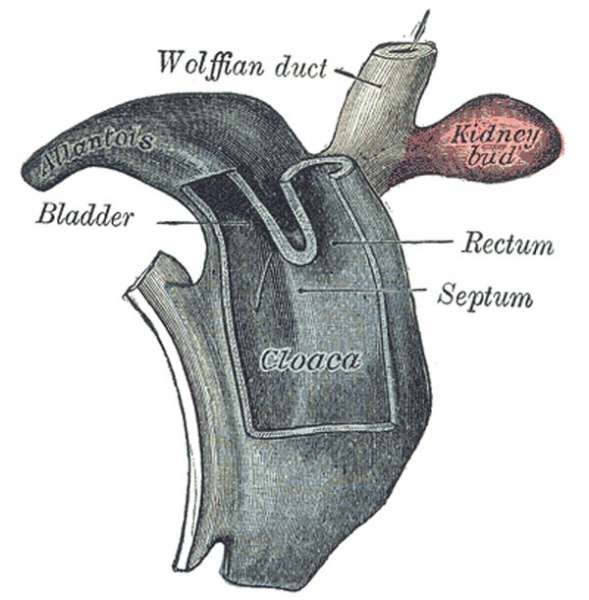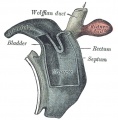File:Gray0992.jpg

Original file (600 × 611 pixels, file size: 73 KB, MIME type: image/jpeg)
Week 4 Human Cloaca
Cloaca of human embryo from twenty-five to twenty-seven days old. (From model by Keibel.)
The entodermal cloaca is divided into a dorsal and a ventral part by means of a partition, the urorectal septum (Fig. 992), which grows downward from the ridge separating the allantoic from the cloacal opening of the intestine and ultimately fuses with the cloacal membrane and divides it into an anal and a urogenital part. The dorsal part of the cloaca forms the rectum, and the anterior part of the urogenital sinus and bladder. For a time a communication named the cloacal duct exists between the two parts of the cloaca below the urorectal septum; this duct occasionally persists as a passage between the rectum and urethra. The anal canal is formed by an invagination of the ectoderm behind the urorectal septum. This invagination is termed the proctodeum, and it meets with the entoderm of the hind-gut and forms with it the anal membrane.
- "entoderm" is the historic name for "endoderm".
- Gray's Images: Development | Lymphatic | Neural | Vision | Hearing | Somatosensory | Integumentary | Respiratory | Gastrointestinal | Urogenital | Endocrine | Surface Anatomy | iBook | Historic Disclaimer
| Historic Disclaimer - information about historic embryology pages |
|---|
| Pages where the terms "Historic" (textbooks, papers, people, recommendations) appear on this site, and sections within pages where this disclaimer appears, indicate that the content and scientific understanding are specific to the time of publication. This means that while some scientific descriptions are still accurate, the terminology and interpretation of the developmental mechanisms reflect the understanding at the time of original publication and those of the preceding periods, these terms, interpretations and recommendations may not reflect our current scientific understanding. (More? Embryology History | Historic Embryology Papers) |
| iBook - Gray's Embryology | |
|---|---|

|
|
Reference
Gray H. Anatomy of the human body. (1918) Philadelphia: Lea & Febiger.
Cite this page: Hill, M.A. (2024, April 26) Embryology Gray0992.jpg. Retrieved from https://embryology.med.unsw.edu.au/embryology/index.php/File:Gray0992.jpg
- © Dr Mark Hill 2024, UNSW Embryology ISBN: 978 0 7334 2609 4 - UNSW CRICOS Provider Code No. 00098G
File history
Click on a date/time to view the file as it appeared at that time.
| Date/Time | Thumbnail | Dimensions | User | Comment | |
|---|---|---|---|---|---|
| current | 15:45, 28 April 2011 |  | 600 × 611 (73 KB) | S8600021 (talk | contribs) | ==Week 4 Human Cloaca== Cloaca of human embryo from twenty-five to twenty-seven days old. (From model by Keibel.) {{Gray Anatomy}} Category:Historic Embryology Category:Gray's 1918 Anatomy Category:Gastrointestinal Tract [[Category:Genit |
You cannot overwrite this file.
File usage
The following 2 pages use this file:
